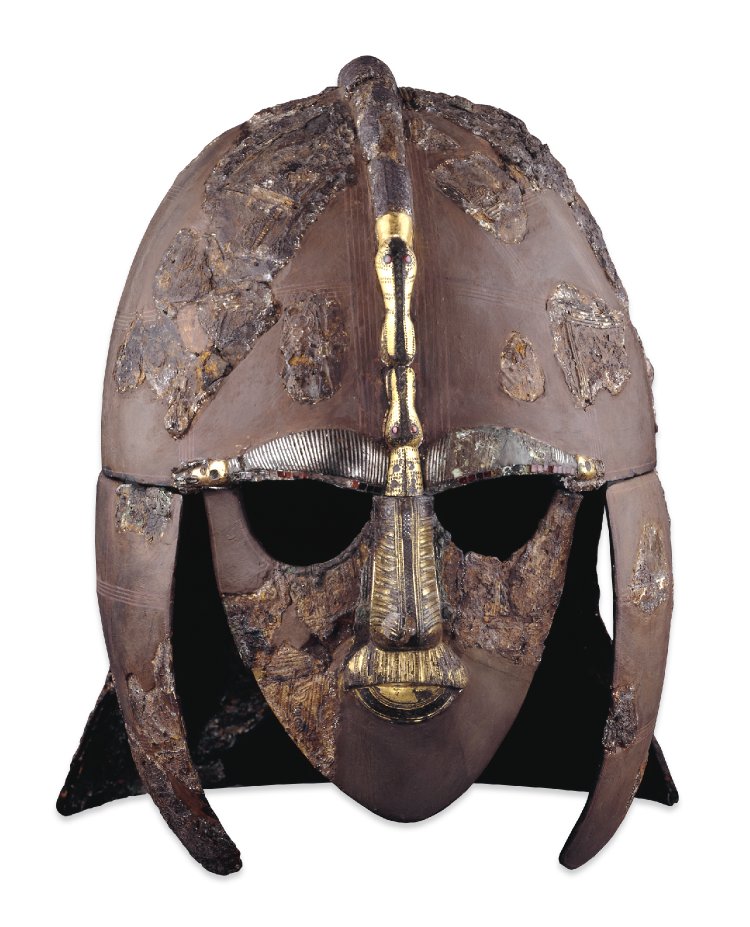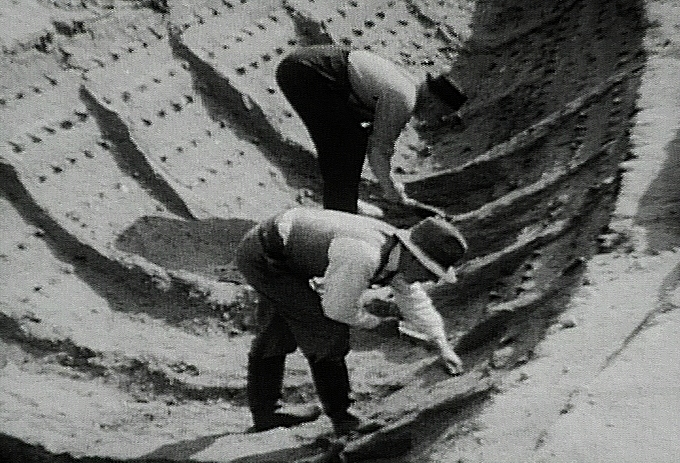The Discovery of the Sutton Hoo Helmet
- 28thJuly 1939 -
 “I think it’s fair to say that the Sutton Hoo helmet is the face of the Anglo-Saxons, perhaps even all of the early middle ages in Europe. It is shown on numerous book covers, got its own commemorative stamp for the 250th anniversary of the British Museum and features in countless documentaries on the period.” Sonja Marzinzik, curator, British Museum and author of the Sutton Hoo Helmetsets out the importance of this find. It has also been labelled as the most important archaeological find in England’s history. It is an image known by millions of school children too, who study the Anglo-Saxon period.
“I think it’s fair to say that the Sutton Hoo helmet is the face of the Anglo-Saxons, perhaps even all of the early middle ages in Europe. It is shown on numerous book covers, got its own commemorative stamp for the 250th anniversary of the British Museum and features in countless documentaries on the period.” Sonja Marzinzik, curator, British Museum and author of the Sutton Hoo Helmetsets out the importance of this find. It has also been labelled as the most important archaeological find in England’s history. It is an image known by millions of school children too, who study the Anglo-Saxon period.
However, when the burial mounds in East Anglia were excavated in 1939, before the onset of the war, the first finds of the helmet were not considered too important. Soon enough the Daily Mail, who else, was talking about a ‘significant’ find. Charles Phillips, the lead archaeologist said this about Friday, 28thJuly, "The crushed remains of an iron helmet were found four feet [1.2 m] east of the shield boss on the north side of the central deposit. The remains consisted of many fragments of iron covered with embossed ornament of an interlace with which were also associated gold leaf, textiles, an anthropomorphic face-piece consisting of a nose, mouth, and moustache cast as a whole (bronze), and bronze zoomorphic mountings and enrichments."
He went on later:
Saturday, 29 July: "A few more fragments of the iron helmet came to light and were boxed with the rest found the day before."
Tuesday, 1 August: "The day was spent in clearing out the excavated stern part of the ship and preparing it for study. Before this a final glean and sift in the burial area had produced a few fragments which are probably to be associated with the helmet and the chain mail respectively."
 Hardly great excitement. Indeed, there were no photographs of the fragments in situnor were their positions recorded. The excavation ended on 24thAugust and the following day all the finds were boxed and shipped out. 9 days later Great Britain declared war on Germany and any hope of intense examination of the objects were severely delayed. Like many objects the artifacts were stored in the Aldwych underground station for most of the duration of the war.
Hardly great excitement. Indeed, there were no photographs of the fragments in situnor were their positions recorded. The excavation ended on 24thAugust and the following day all the finds were boxed and shipped out. 9 days later Great Britain declared war on Germany and any hope of intense examination of the objects were severely delayed. Like many objects the artifacts were stored in the Aldwych underground station for most of the duration of the war.
By the end of 1944 the pieces were removed – nearly 500 of them. It was thought the helmet belonged to the King of the East Angles, Raedwald, who was buried around 625AD. The elaborate decoration on the helmet led many to assume that the helmet was more of a crown rather than a practical war helmet.
The mound, one of 18 at the site, but, seemingly, the only one not to have been ransacked, at Woodbridge, Suffolk, was believed to be a burial similar to those of the sea-faring rulers of Scandinavia and originally contained a 90-foot-long boat. The wood had rotted away leaving just the outline and the iron rivets that had joined the planks together. The boat would have been pulled in-land from the River Deben and the used as the centre piece for a royal burial, similar to the one in the tale of Beowulf, who originates from Southern Sweden. In the Anglo-Saxon world rulers had to demonstrate they could lead in war – success in this led to stability and control as well as possible expansion. Thus the status of the burial objects was very important and it would have been seen as an key political statement. Although the idea of a ship burial is a pagan ritual, this time overlapped with the arrival of Christianity and there are definite Christian symbols to be seen on some of the objects – which included armour, weapons, silver dishes, feasting equipment such as drinking horns, bottles and plates, coins and fasteners for purses, belts and clothes.
The first reconstruction of the pieces was done by 70-year-old Herbert Maryon, who admitted that he had to carry out the work with mainly one eye. It took him six months’ continuous work to complete the helmet which was like doing a jigsaw puzzle without a picture, with missing pieces and broken edges. This was done between 1945 and 1946. Unfortunately, his work came in for some criticism about the moving pieces and the design – particularly from historians in Sweden who had similar finds.
Between 1965 and 1970 further excavations were done on the mound and four more pieces were found. This led to further work on the helmet in 1970 by Nigel Williams, who was in his mid-twenties and had worked for the British Museum his whole career to date. He completely disassembled the helmet, taking him four months, then spent the next five months looking at the parts before a further nine months re-assembling them. He initially used long pins to hold the pieces together then, using jute and adhesive, moulded to shape the missing pieces. He resin coated the edges to stick it all together. The final height of the helmet was 31.8cm with a circumference of 74.6cm and weighed in at 2.5kg.
A description of the helmet is best given by the British Museum itself. “Iron and tinned copper alloy helmet, consisting of many pieces of iron, now built into a reconstruction, forming cap, cheek-pieces, mask and neck-guard. Covered with panels of tinned copper alloy sheeting. The copper alloy sheets are stamped with various patterns including animal interlace, and warrior motifs depicted in two panels. Three different dies were used for the figural scenes and two for the interlace. The warrior motifs are known as the "Dancing Warrior" and "Fallen Warrior". A crest runs over the cap of the helmet and leads down the face in a straight line, forming the nose, which is gilt copper alloy. The crest itself is of iron and has gilt animal terminals at the forehead and back of the head, the animals having cloisonné garnet eyes. The iron crest and copper alloy eyebrows are inlaid with silver wire; the eyebrows have gilt zoomorphic terminals consisting of boar heads, and strips of garnet cloisonné work immediately above the eye sockets. The nose and mouth-piece are cast as one; they are made of parcel-gilt and partly tinned copper alloy, with engraved detail and silver inlay.”
It gives a definition of tinning as ‘A technique in which a thin layer of tin is applied to an otherwise non-tin item to give it an impression of being made of silver.’
Sonja Marzinzikcontinues,“My favourite reinterpretation is found on a Swedish brand of pickled herrings. An image of the Sutton Hoo helmet has been modified to give a gentle smile, presumably in anticipation of the delicacies inside. The big question has always been how the Sutton Hoo helmet relates to other helmets from this time found in Scandinavia. Having seen a number of them in the flesh, I am convinced that whoever made the Anglo-Saxon helmet must have known the Swedish example. Although each helmet is an individual piece, they all have commonalities that unite them as a group. In addition, there’s the presence of the same motifs on the repoussé panels, for example the spear dancers and the fallen warrior, and the similarity of wire-inlaid eyebrows and animal heads cannot be a coincidence.
Whether this was because the Sutton Hoo helmet came from Scandinavia, whether it was made by a Swedish craftsman travelling to East Anglia, or by an Anglo-Saxon craftsman who had travelled eastwards is a riddle still to be resolved.”
Perhaps the best description, both of the piece itself and the wider importance of this most significant and famous find in the British Isles, is given by Martin Carver, Professor Emeritus, Department of Archaeology, University of York. “The helmet is the armoured head of a warrior, attended by gods. Made of hammered iron, proof against spear, sword and axe, it is also covered with protective metaphors.
Across the face is a bird with splayed wings, its body forming the warrior’s nose, the tail his moustache and the wings his eyebrows. The bird soaring up meets the jaws of a dragon plunging down, its thick iron body inlaid with zigzag silver wire curving over the crest.
The man’s head is equipped with defence at every angle, like a battle ship: the wingtips finish in wild-boar jaws, guarding the lateral blind spots; the dragon has a snarling mouth at its tail, bringing up the rear. All the heads, even the bird’s, have sets of sharp fangs: the bared teeth of the animal bodyguard.
On the top of the crest is a little hole to carry a plume, and the sides of the helmet carried small panels commemorating victories – an enemy ridden down by a horseman, triumphant warriors dancing. Dragon and bird each have two gleaming eyes of red polished garnet, extra vision for the warrior’s own eyes, watching within their hollows, menacing as dark glasses.
Dragon, wild boar, bird of prey – these are the symbolic animals of Anglo-Saxon East Anglia where the helmet was found – part of an immense treasure buried with a political leader in a chamber, in a ship, in the early seventh century AD. Helmet and ship-burial were elements of a language of belief then shared widely among the peoples of the Northern Seas. In partnership with their animal gods, men win battles, hoard wealth, claim land. Ruthless, brave, enduring, these people built the kingdoms that northern Europe still has.
The Sutton Hoo helmet is more than a face-guard – it is a poem, a political manifesto in silver and iron. “
The finds from the mound are on display in the British Museum and in 2017 they were moved to a new room – number 41 – specially designed to hold these most precious finds.


